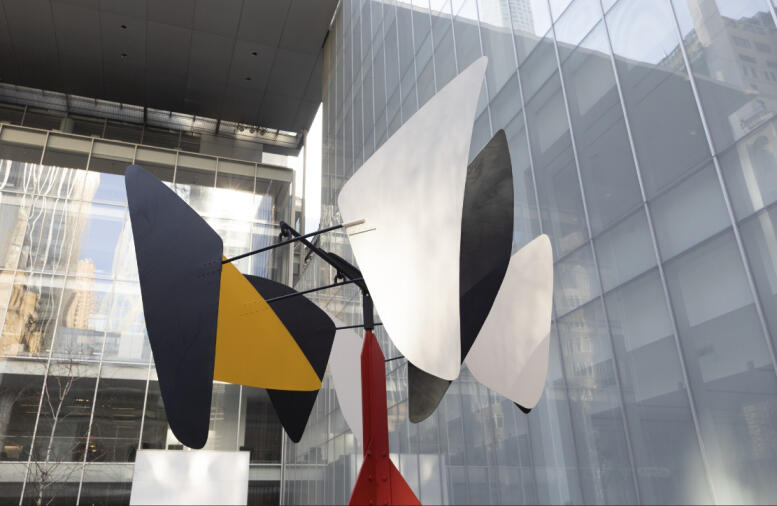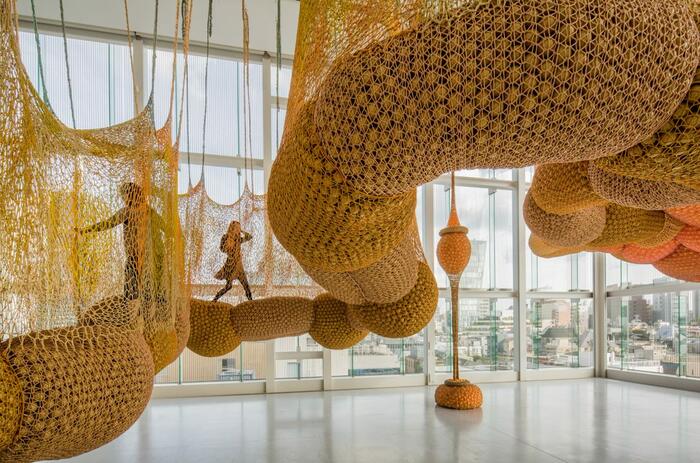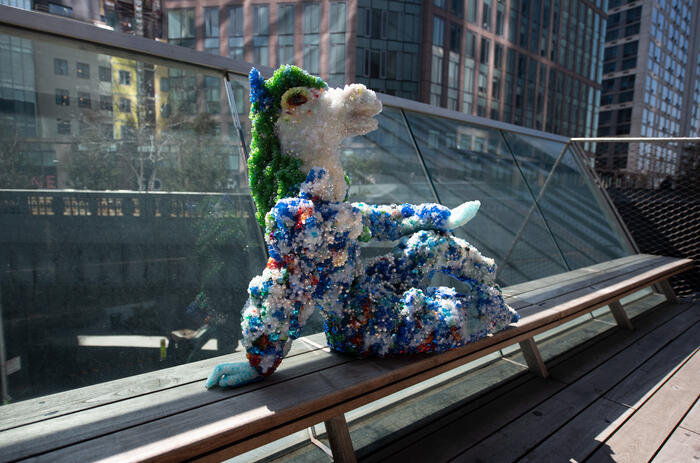MoMA EXHIBITS ALEXANDER CALDER: MODERN FROM THE START
Drawn from MoMA’s collection and augmented with key loans from the Calder Foundation, the exhibition on view in the Sculpture Garden celebrates one of the most beloved artists of the 20th century and presents rarely seen works.

Alexander Calder (1898 – 1976) conceived of sculpture as an experiment in space and motion. Ranging from delicate, intimate, figurative objects in wood and wire, to hanging sculptures that move, to monumentally scaled abstract works in steel and aluminum, Calder’s art suggests the elemental systems that animate life itself.
A 1930 visit to the Dutch painter Piet Mondrian’s Paris studio—a workspace arranged like an abstract environment—prompted a radical shift in Calder’s art, from an art of observing things in the world toward an art that opens up a world unto itself. He began to develop the kind of work for which he would become best known: the mobile—an abstract sculpture that moves—so named by Calder’s friend Marcel Duchamp. With this new art form came a new set of possibilities for what a sculpture might be.
-
Publicity photograph of Calder during the installation of “Alexander Calder: Sculptures and Constructions” (September 29, 1943–January 16, 1944). 1943. Gelatin silver print. Photographic Archive, The Museum of Modern Art Archives, New York. © 2021 Calder Foundation, New York / Artists Rights Society (ARS), New York
-
Alexander Calder - Marion Greenwood - New York, early 1928. © 2021 Calder Foundation, New York / Artists Rights Society (ARS), New York
-
Alexander Calder - Black Widow - Waterbury, Connecticut, 1959. © 2021 Calder Foundation, New York / Artists Rights Society (ARS), New York
-
Alexander Calder. Cow. 1929. © 2021 Calder Foundation, New York / Artists Rights Society (ARS), New York
-
Alexander Calder. In-text plate (page 86) from Fables of Aesop. 1931. © 2021 Calder Foundation, New York / Artists Rights Society (ARS), New York
-
Alexander Calder. Untitled. 1939. © 2021 Calder Foundation, New York / Artists Rights Society (ARS), New York
-
Alexander Calder. Untitled. 1941. © 2021 Calder Foundation, New York / Artists Rights Society (ARS), New York
-
Alexander Calder. Untitled. (n.d.). © 2021 Calder Foundation, New York / Artists Rights Society (ARS), New York
Alexander Calder reimagined sculpture as an experiment in space and motion, upending centuries-old notions that sculpture should be static, grounded, and dense by making artworks that often move freely and interact with their surroundings. “One of Calder’s objects is like the sea,” wrote the philosopher Jean-Paul Sartre, “always beginning over again, always new.” Bringing together early wire and wood figures, works on paper, jewelry, mobiles in motion, and monumental abstract sculptures, the exhibition takes a deep dive into the full breadth of Calder’s career and inventiveness.
Calder’s ever-changing artworks invite a viewer’s sustained attention; and The Museum of Modern Art has provided a setting for this productive exchange ever since his work was first exhibited here in 1930, just months after the Museum opened its doors. This exhibition looks at Calder’s work through the lens of this connection. Throughout MoMA’s formative years, Calder, in his unofficial role as “house artist,” was called upon to produce several commissioned works—including Lobster Trap and Fish Tail, a multicolored mobile that hangs in the same stairwell for which it was made in 1939. His works have been a mainstay of the Museum’s galleries and Sculpture Garden ever since.
-
Installation view of the exhibition "Alexander Calder: Modern from the Start". Photograph by Robert Gerhardt.
-
Installation view of the exhibition "Alexander Calder: Modern from the Start". Photograph by Robert Gerhardt.
-
Alexander Calder. Lobster Trap and Fish Tail. Roxbury, Connecticut, 1939. © 2021 Calder Foundation, New York / Artists Rights Society (ARS), New York
-
Alexander Calder. Lobster Trap and Fish Tail. Roxbury, Connecticut, 1939. © 2021 Calder Foundation, New York / Artists Rights Society (ARS), New York
-
Alexander Calder. Sandy's Butterfly. 1964. © 2021 Calder Foundation, New York / Artists Rights Society (ARS), New York
-
Installation view of the exhibition "Alexander Calder: Modern from the Start". Photograph by Denis Doorly.





